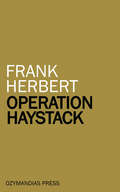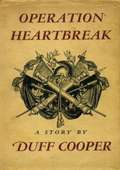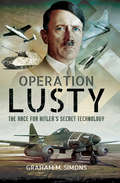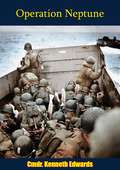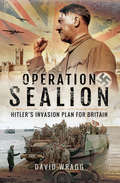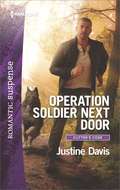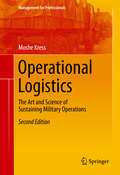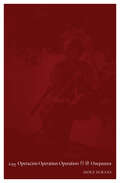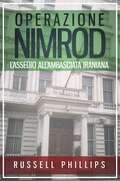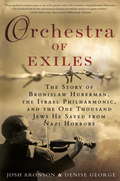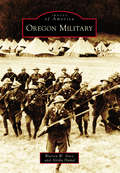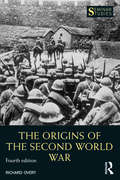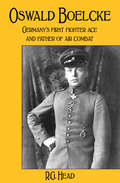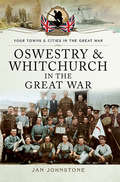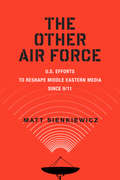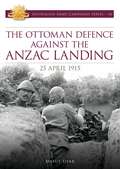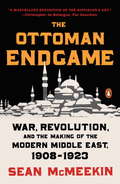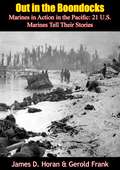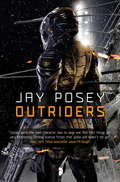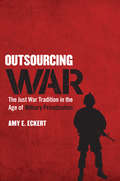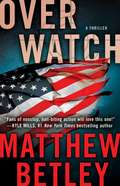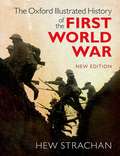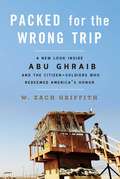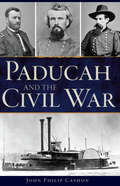- Table View
- List View
Operation Haystack
by Frank HerbertIt's hard to ferret out a gang of fanatics; it would, obviously, be even harder to spot a genetic line of dedicated men. But the problem Orne had was one step tougher than that!
Operation Heartbreak: A Story (Persephone Book Ser. #No. 58)
by Duff CooperFirst published in 1950, Operation Heartbreak tells the fictional story of Wilie Marygton, a career soldier who was too young for WWI and too old for WWII. Born into a military family, Willie's one goal in life is to take part in a battle, so he is exhilarated when he receives his commission, and is scheduled to leave for the Western Front on November 9, 1918. However, news of the Armistice changes his orders, and he instead spends the next 20 years in various posts in India and Africa, where his main occupation seems to be big game hunting and polo. With the rise of fascism, he is ready to resign his commission to fight in Spain, but is persuaded otherwise and spends WWII training recruits, lamenting his military status. But in an ironic twist of fate, he does end up playing an important part in the war effort....
Operation Lusty: The Race for Hitler's Secret Technology
by Graham M. SimonsA fascinating overview of the Allies&’ post-WWII program to gain access to advanced Nazi war machines and the technology they ultimately recovered. Prior to the Allied D-Day assault on Normandy, France, rumors had already been circulating that high-tech Nazi super-weapons (wunderwaffe) had reached or were near completion. At the war&’s end, a mad scramble ensued to discover the enemy&’s secrets, fueled in large part by a US desire to regain its technological edge and to keep these weapons out of Soviet hands. Operation Lusty (LUftwaffe Secret TechnologY) was in full swing. In Operation Lusty, aviation historian Graham M. Simons delivers a comprehensive and detailed history of the program while cataloging the advanced war equipment that was ultimately discovered—from U-boats, carriers, and battleships to radar equipment and operating systems, to fighters, bombers, rockets, and other V-weapons. With access to previously unreleased documentation and wide-ranging archival materials, Simons distinguishes what was fact in the Nazi arsenal from what was pure fantasy, dreamed up by Joseph Goebbels&’s powerful propaganda machine. Operation Lusty sheds new light on the furious race for postwar technological superiority, and offers an insider&’s look at the full spectrum of military spoils that were gained.
Operation Neptune [Illustrated Edition]
by Cmdr. Kenneth Edwards'Operation Neptune' was the codename for the naval component of the invasion of France in June 1944. The complete invasion codename was 'Operation Overlord', and 'Neptune' was phase one of a much bigger plan. Nevertheless, the task of safely landing 160,000 men with all of the supporting equipment was an operation on an unprecedented scale.The operation, planned by a team under Lieutenant-General Frederick Morgan, was the largest amphibious invasion in world history and was executed by land, sea, and air elements under direct British command with over 160,000 troops landing on 6 June 1944. Of these, 73,000 were American troops, 61,715 British and 21,400 Canadian.To achieve the successful landings, 195,700 Allied naval and merchant navy personnel in over 5,000 ships were involved. The invasion required the transport of soldiers and material from England by troop-laden aircraft and ships, the assault landings, air support, naval interdiction of the English Channel and naval fire-support. The landings took place along a 50-mile stretch of the Normandy coast divided into five sectors: Utah, Omaha, Gold, Juno, and Sword.The planning required for such a mammoth undertaking was vast, and all to be maintained under the strictest secrecy. The fact that the Germans were caught by surprise is incredible, and a great debt of gratitude is owed to the men and women who worked so hard to bring off the greatest sea-borne invasion in history.This book, written only one year after the invasion by a senior British naval officer who was closely involved, provides the detail behind the conception, planning and successful execution of 'Neptune'. Richly illustrated throughout.
Operation Sealion: Hitler's Invasion Plan for Britain
by David WraggDuring the Summer of 1940, Hitlers Germany appeared unstoppable. The Nazis were masters of mainland Europe, in alliance with Stalins Russia and only the English Channel prevented an immediate invasion.Britain stood alone. The BEF had been routed but, due to the Dunkirk miracle, most of her manpower had returned albeit without their transport and heavy equipment and guns. There was no doubt that the Nazis planned to invade all intelligence pointed that way. In the event it never materialised, thanks to the outcome of the Battle of Britain and Hitlers decision to invade Russia.Operation SEALION examines just how realistic the German threat of invasion was. The author studies the plans, the available capability and resources, the Germans record in Norway and later Crete. The author weighs these against the state of Britains defences and the relative strengths of the land, air and particularly naval forces.The result is a fascinating study of what might or might not have been.
Operation Soldier Next Door
by Justine DavisThe Cutter's Code series continues with a hero who fights to remember...and love Instead of a peaceful homecoming, wounded warrior Tate McLaughlin faces an explosion, near-electrocution and Cutter, an incredibly smart dog. Worse, the sexy veteran needs Lacy-the pretty girl next door-to leave him alone! He's been hurt too many times to risk his heart again. To Lacy Steele, it's apparent that the attacks on her neighbor were no accident. Someone is after him, but his damaged memory offers no clue who! But as they investigate, Lacy finds an intimacy with Tate neither of them has ever known. And it's that bond-and secrets from his deployment-that threatens his life and heart.
Operational Logistics
by Moshe KressThis book explores the theoretical foundations and applications of military operational logistics (OpLog). OpLog theory has two facets: qualitative and quantitative. The qualitative facet is imbedded in the theory of operational level of war or operational art. It includes principles, imperatives and tenets, which are stated and analyzed in the first few chapters. The quantitative facet relates to the scientific aspects of OpLog. It is manifested by formal network models representing structural and operational features of an OpLog system. The book examines the two facets and integrates them into a unified presentation. Important OpLog applications a re described and discussed. Chapter 1 presents a general introduction to military logistics. Chapter 2 discusses the px;font-family: monospace;">general structure and characteristics of logistics and describes its three levels - strategic, operational and tactical. Chapter 3 describes the foundation of OpLog. Chapter 4 deals with OpLog planning. Chapter 5 addresses the issue of logistic information, and Chapter 6 deals with forecasting logistic demands. Chapters 7 and 8 are new additions to this second edition. They address logistics aspects of two contemporary operational topics - insurgencies and humanitarian assistance. Chapter 9 describes the first version of the logistic network model. Chapter 10 addresses an important OpLog characteristic - Flexibility. Chapter 11 discusses two major challenges in OpLog practice: force accumulation, 4419px; font-family: monospace;">and medical treatment and evacuation. Chapter 12 presents an inter-temporal network optimization model designed to determine deployment and employment of 3333px;font-family: monospace;">the OpLog support chain during military operations.
Operations
by Moez SuraniFrom poet-provocateur Moez Surani comes Operations—a book-length poetic inventory of contemporary rhetoric of violence and aggression, as depicted through the evolution of the language used to name the many military operations conducted by UN Member Nations since the organization's inception in 1945. With Operations, Surani draws on contemporary poetic traditions, including conceptual and inventory poetics, to accomplish two important things: On the one hand, he shows that no word is free from connoting violence, while on the other hand, he provokes readers to consider whether their personal values match the values of the military operation that are conducted by their countries. By pulling military language away from euphemism--effectively, making it account for its doublespeaking ways—Operations gives voice to the many lives lost in conflicts around the world, in a volume that will speak equally to lovers of contemporary poetry, language, and linguistics, as to readers interested in politics, international relations, and public discourse.
Operazione Nimrod: L’Assedio all’Ambasciata Iraniana
by Russell PhillipsBasandosi su ricerche approfondite, Operazione Nimrod dissipa i miti e rivela la verità di quei sei lunghi giorni e del drammatico salvataggio che portò il SAS alla ribalta. <P><P> Il 29 aprile 1980 la polizia britannica aveva assicurato all'Iran che la sua ambasciata era al sicuro. Il giorno dopo dei terroristi presero d'assalto l'ambasciata e catturarono ventisei ostaggi. Con il governo iraniano disposto a lasciare che gli ostaggi divenissero martiri e il governo britannico disposto a trattare solo a fronte della resa dei terroristi, ventisei vite erano appese a un filo. <P><P> Ciò che seguì furono sei giorni di tensione e terrore. Tutto finì quando il SAS lanciò un'audace missione di salvataggio, trasmessa in diretta televisiva. Milioni di persone trattennero il respiro, in attesa di conoscere il risultato dell'Operazione Nimrod. <P><P> Compra questo libro per conoscere la verità su una delle missioni di soccorso più drammatiche mai condotte dal SAS.
Orchestra of Exiles
by Josh Aronson Denise GeorgeThe compelling biography of the violinist who founded the Palestine Symphony Orchestra and saved hundreds of people from Hitler--as seen in Josh Aronson's documentary Orchestra of Exiles."The true artist does not create art as an end in itself. He creates art for human beings. Humanity is the goal."--Bronislaw HubermanAt fourteen, Bronislaw Huberman played the Brahms Violin Concerto in Vienna-- winning high praise from the composer himself, who was there. Instantly famous, Huberman began touring all over the world and received invitations to play for royalty across Europe. But after witnessing the tragedy of World War I, he committed his phenomenal talent and celebrity to aid humanity.After studying at the Sorbonne in Paris, Huberman joined the ranks of Sigmund Freud and Albert Einstein in calling for peace through the Pan European Movement. But when hope for their noble vision was destroyed by the rise of Nazism, Huberman began a crusade that would become his greatest legacy--the creation, in 1936, of the Palestine Symphony, which twelve years later became the Israel Philharmonic Orchestra.In creating this world-level orchestra, Huberman miraculously arranged for the very best Jewish musicians and their families to emigrate from Nazi-threatened territories. His tireless campaigning for the project--including a marathon fundraising concert tour across America--ultimately saved nearly a thousand Jews from the approaching Holocaust. Inviting the great Arturo Toscanini to conduct the orchestra's first concert, Huberman's clarion call of art over cruelty was heard around the world. His story contains estraordinary adventures, riches and royalty, politicians and broken promises, losses and triumphs. Against near impossible obstacles, Huberman refused to give up on his dream to create a unique and life-saving orchestra of exiles which was one of the great cultural achievements of the 20th century.Includes Photographs
Oregon Military (Images of America)
by Alisha Hamel Warren W. AneyOregon's military heritage goes back thousands of years, including native people's warrior traditions. Most of the cultures in this region were relatively peaceful, even welcoming visiting strangers, such as the Lewis and Clark overland Army expedition in 1805-1806. Then, overwhelming numbers of fur trappers, merchants, settlers, and miners began taking over traditional native grounds. From 1847 to 1880, native peoples experienced eight major conflicts with Army and volunteer forces. Army units built several forts from Oregon's coast to the Great Basin. Oregonians adopted militia laws, served in volunteer units, and organized the Oregon State Militia, which became the Oregon National Guard in 1887. The Guard benefited the state in many civil-support actions and served the nation in major overseas conflicts from the Spanish-American War to the current Operation Enduring Freedom.
The Origins of the Second World War
by Richard OveryExploring the reasons why the Second World War broke out in September 1939 and why a European conflict developed into a war that spanned the globe, The Origins of the Second World War argues that this was not just ‘Hitler’s War’ but one that had its roots and origins in the decline of the old empires of Britain and France and the rise of ambitious new powers in Germany, Italy and Japan who wanted large empires of their own. This fourth edition has been revised throughout, covering the origins of the war from its background in the First World War to its expansion to embrace the Soviet Union, Japan and the United States by the end of 1941. Creating a comprehensive and analytical narrative while remaining a succinct overview of the subject, this book takes a thematic approach to the complex range of events that culminated in global warfare, discussing factors such as economic rivalry, rearmament and domestic politics and emphasising that any explanation of the outbreak of hostilities must be global in scope. Containing updated references and primary source documents alongside a glossary, a chronology of key events and a Who’s Who of important figures, this book is an invaluable introduction for any student of this fascinating period.
Oswald Boelcke: Germany's First Fighter Ace and Father of Air Combat
by R. G. HeadThis biography of the pioneering WWI flying ace who mentored the Red Baron is “fascinating . . . [it] captures combat aviation at its inception” (MiG Sweep: The Magazine of Aviation Warriors). With a total of forty victories, Oswald Boelcke was Germany’s first ace in World War I—and a century later he remains a towering figure in the history of air warfare, renowned for his character, inspirational leadership, organizational genius, development of air-to-air tactics, and impact on aerial doctrine. Paving the way for modern air forces across the world with his pioneering strategies, Boelcke had a dramatic effect on his contemporaries. The famed Red Baron’s mentor, instructor, squadron commander, and friend, he exerted a tremendous influence upon the German air force. He was one of the first pilots to be awarded the famous Pour le Mérite, commonly recognized as the “Blue Max.” All of this was achieved after overcoming medical obstacles in childhood and later life with willpower and determination. Boelcke even gained the admiration of his enemies: After his tragic death in a midair collision, Britain’s Royal Flying Corps dropped a wreath on his funeral, and several of his captured foes sent another wreath from their German prison camp. His name and legacy live on, as seen in the Luftwaffe’s designation of the Tactical Air Force Wing 31 “Boelcke.” This definitive biography reveals his importance as a fighter pilot who set the standard in military aviation.
Oswestry & Whitchurch in the Great War (Your Towns & Cities in the Great War)
by Janet JohnstoneAt the outbreak of hostilities, Oswestry and Whitchurch in rural north Shropshire were busy market towns that depended largely on agriculture for a living and justly famed for butter and cheese production. Within weeks of Lord Kitcheners impassioned call for volunteers, scores of local men, many employed in farm work, had accepted the kings shilling and travelled to training camps, some never to return.Those left behind were soon experiencing changes, as rules and regulations were swiftly implemented by the Defence of the Realm Act. Food shortages became apparent, rationing was introduced, private houses were turned into auxiliary hospitals, Belgium refugees arrived, and lighting restrictions came into force. Shortages of men resulted in women taking on the mens tasks; they coped very successfully, leading to lasting changes in attitude.Two of the biggest training camps in the country Park Hall, Oswestry and Prees Heath, Whitchurch were constructed on land just a few miles distant from the towns boundaries, and people had to learn quickly to cope with a massive influx of soldiers. Photographs illustrating the building of one of the camps have been included in this book, to demonstrate just how much was achieved in such a short period of time.Using information and illustrations gleaned from various sources, this book endeavours to paint a true picture of what life was like on the Home Front throughout the conflict, and hopes to keep alive the memory of the men who fought in the war and the women and children who remained at home anxiously waiting for their loved ones to return.
The Other Air Force: U.S. Efforts to Reshape Middle Eastern Media Since 9/11
by Mr Matt SienkiewiczAs it seeks to win the hearts and minds of citizens in the Muslim world, the United States has poured millions of dollars into local television and radio programming, hoping to generate pro-American currents on Middle Eastern airwaves. However, as this fascinating new book shows, the Middle Eastern media producers who rely on these funds are hardly puppets on an American string, but instead contribute their own political and creative agendas while working within U.S. restrictions. The Other Air Force gives readers a unique inside look at television and radio production in Afghanistan and the Palestinian territories, from the isolated villages of the Afghan Panjshir Valley to the congested streets of Ramallah. Communications scholar Matt Sienkiewicz explores how the U.S. takes a "soft-psy" approach to its media efforts combining "soft" methods of encouraging entertainment programming, such as adaptations of The Voice and The Apprentice with more militaristic "psy-ops" approaches to information control. Drawing from years of field research and interviews with everyone from millionaire executives to underpaid but ever resourceful cameramen, Sienkiewicz considers the perspectives of the Afghan and Palestinian media workers trying to forge viable broadcasting businesses without straying outside American-set boundaries for acceptable content. As it carefully examines the interplay of U.S. military and economic might with the capacity for local ingenuity and resistance, the book also analyzes the intriguingly complex programming that emerges from this tension. Combining eyewitness reportage with cutting-edge scholarship, The Other Air Force reveals the remarkable creative output that can emerge even from the world's tensest conflict zones.
The Ottoman Defence Against the ANZAC Landing - 25 April 1915 (Australian Army Campaigns Series #16)
by Mesut UyarThe landing at Gallipoli on 25 April 1915 represents a defining moment, not only for Australia and New Zealand, but also for Turkey. However a detailed account of the landing from the Turkish perspective has yet to be published in English despite the 100 years that has elapsed since the first ANZACs scrambled ashore. Descriptions of the Ottoman forces such as the composition of units, the men who commanded them, their weapons, capabilities and reactions to the ANZAC invasion have generally remained undocumented or described in piecemeal fashion based on secondary sources. The lack of a Turkish perspective has made it almost impossible to construct a balanced account of the events of that fateful April day. The Ottoman Defence against the Anzac Landing: 25 April 1915 seeks to redress this imbalance, portraying the Ottoman experience based on previously unpublished Ottoman and Turkish sources. This meticulously researched volume describes the Ottoman Army in fascinating detail from its order of battle, unit structure and composition, training and doctrine to the weapons used against the ANZACs. Using Ottoman military documents, regimental war diaries, personal accounts and memoirs, author Mesut Uyar describes the unfolding campaign, unravelling its complexity and resolving many of the questions that have dogged accounts for a century. This valuable chronicle will enhance readers&’ understanding of the Ottoman war machine, its strengths and weaknesses and why it proved so successful in containing the Allied invasion. Detailed maps and photographs published for the first time add clarity and portray many of the men the ANZACs referred to with grudging respect as &‘Johnny Turk&’.
The Ottoman Endgame: War, Revolution, and the Making of the Modern Middle East, 1908-1923
by Sean McmeekinAn astonishing retelling of twentieth-century history from the Ottoman perspective, delivering profound new insights into World War I and the contemporary Middle EastBetween 1911 and 1922, a series of wars would engulf the Ottoman Empire and its successor states, in which the central conflict, of course, is World War I--a story we think we know well. As Sean McMeekin shows us in this revelatory new history of what he calls the "wars of the Ottoman succession," we know far less than we think. The Ottoman Endgame brings to light the entire strategic narrative that led to an unstable new order in postwar Middle East--much of which is still felt today.The Ottoman Endgame: War, Revolution, and the Making of the Modern Middle East draws from McMeekin's years of groundbreaking research in newly opened Ottoman and Russian archives. With great storytelling flair, McMeekin makes new the epic stories we know from the Ottoman front, from Gallipoli to the exploits of Lawrence in Arabia, and introduces a vast range of new stories to Western readers. His accounts of the lead-up to World War I and the Ottoman Empire's central role in the war itself offers an entirely new and deeper vision of the conflict. Harnessing not only Ottoman and Russian but also British, German, French, American, and Austro-Hungarian sources, the result is a truly pioneering work of scholarship that gives full justice to a multitiered war involving many belligerents. McMeekin also brilliantly reconceives our inherited Anglo-French understanding of the war's outcome and the collapse of the empire that followed. The book chronicles the emergence of modern Turkey and the carve-up of the rest of the Ottoman Empire as it has never been told before, offering a new perspective on such issues as the ethno-religious bloodletting and forced population transfers which attended the breakup of empire, the Balfour Declaration, the toppling of the caliphate, and the partition of Iraq and Syria--bringing the contemporary consequences into clear focus.Every so often, a work of history completely reshapes our understanding of a subject of enormous historical and contemporary importance. The Ottoman Endgame is such a book, an instantly definitive and thrilling example of narrative history as high art.
Out in the Boondocks: 21 U.S. Marines Tell Their Stories
by Gerold Frank James D. HoranHere, in heart-stopping human detail, are twenty-one personal accounts from these men--stories told by the men themselves. They are the stories of men who have lived in hell and lived to tell of it. Here is Sgt. Albert Schmid who was awarded the Navy Cross for his single-handed destruction of a flanking attack, during which he accounted for 200 Japs on Guadalcanal. Here is Private Nicolli who was literally blown into the air like a matchstick and then, with a piece of shrapnel in his chest, helped a wounded comrade to the rear. Here is the story of a Marine gunner in a Navy dive-bomber, and the story of "the luckiest Marine in the Solomons" whose tonsils were neatly eliminated by a Jap sniper, and many others.If you want to know how our boys are taking this war, if you want the complete stories behind the headlines from the Pacific, this should be your book. Your blood will run faster as you, yourself, spend memorable days and nights "out in the boondocks."
The Outlook for Arab Gulf Cooperation
by Dalia Dassa Kaye Cordaye Ogletree Daniel Egel Jeffrey Martini Becca WasserThis report examines what binds and divides the six Gulf Cooperation Council (GCC) states--Bahrain, Kuwait, Oman, Qatar, Saudi Arabia, and the United Arab Emirates--and presents the outlook for the GCC's evolution over the next ten years. The study aims to help policymakers better understand intra-GCC dynamics and prepare for future trends in a region with high stakes for U.S. strategic interests.
Outriders
by Jay PoseyThe start of a Military SF series from imprint best-seller and Tom Clancy game series writer Jay Posey.Captain Lincoln Suh died on a Wednesday. And things only got harder from there.Snatched out of special operations and thrown headfirst into a secretive new unit, Lincoln finds himself as the team leader for the 519th Applied Intelligence Group, better known as the Outriders. And his first day on the job brings a mission with the highest possible stakes.A dangerously cunning woman who most assuredly should be dead has seemingly returned. And her plans aren't just devastating, they might be unstoppable.How do you defeat a hidden enemy when you can't let them know they've been discovered?You send in the Outriders.File Under: Science FictionFrom the Paperback edition.
Outsourcing War: The Just War Tradition in the Age of Military Privatization
by Amy E. EckertRecent decades have seen an increasing reliance on private military contractors (PMCs) to provide logistical services, training, maintenance, and combat troops. In Outsourcing War, Amy E. Eckert examines the ethical implications involved in the widespread use of PMCs, and in particular questions whether they can fit within customary ways of understanding the ethical prosecution of warfare. Her concern is with the ius in bello (right conduct in war) strand of just war theory. Just war theorizing is generally built on the assumption that states, and states alone, wield a monopoly on the legitimate use of force. Who holds responsibility for the actions of PMCs? What ethical standards might they be required to observe? How might deviations from such standards be punished? The privatization of warfare poses significant challenges because of its reliance on a statist view of the world. Eckert argues that the tradition of just war theory—which predates the international system of states—can evolve to apply to this changing world order. With an eye toward the practical problems of military command, Eckert delves into particular cases where PMCs have played an active role in armed conflict and derives from those cases the modifications necessary to apply just principles to new agents in the landscape of war.
Overwatch: A Thriller (The Logan West Thrillers #1)
by Matthew BetleyThe Military Times’s Top Ten Books of 2016 Pick “A former Marine himself, Betley proves himself an able heir to the throne currently held by the likes of Brad Thor and the late, great Vince Flynn. But Betley also incorporates a quest for a historical artifact reminiscent of James Rollins and Steve Berry, resulting in a structurally flawless read, unafraid to tackle difficult issues like PTSD as well. Not to be missed.” —The Providence Journal “Matthew Betley has proven he’s an accomplished writer. Overwatch is a brilliantly conceived thriller that surges from the first chapter through mounting deception to a powerful conclusion.” —Clive Cussler, #1 New York Times bestselling author “Overwatch is an exceptional read—a thoroughly engrossing thriller that reminds us of battles fought and threats we still face. We might have expected from Matthew Betley the gripping battlefield accounts that could only come from a seasoned warrior. But the humanity of its characters and the relentless drive of its narrative will make readers impatient for Betley’s next book.” —Stephen Hayes, The Weekly Standard “As a former Marine, Betley really knows his stuff. Fans of nonstop, nail-biting action will love this one!” —Kyle Mills, #1 New York Times bestselling authorWhen Logan West impulsively answers a dead man’s ringing phone, he triggers a global race against the clock to track down an unknown organization searching for an Iraqi artifact that is central to a planned attack in the Middle East—one that will draw the United States into a major conflict with Iran. Logan, a former Marine officer, is quickly contracted as a “consultant” to assist the FBI as part of a special task force bent on stopping the shadowy operatives, whatever the cost. The battles are nonstop, from the plains of the Midwest, to mansions in northern Mexico, to the war-torn Al-Anbar province, pitting an international team against trained mercenaries employed by the world’s largest private security contractor...whose owner has a personal vendetta against the US government. Meanwhile, Logan is battling his own demons, especially the trauma of the ambush that his Force Recon unit suffered at an insurgent torture compound in Fallujah in 2004, which threatens to destroy everything he holds dear. With high-stakes and fully-realized characters, Overwatch is a thriller unlike any you’ve read before: deftly plotted, up-to-the-minute, and impossible to put down.
The Oxford Illustrated History of the First World War: New Edition
by Hew StrachanThe First World War, now a century ago, still shapes the world in which we live, and its legacy lives on, in poetry, in prose, in collective memory and political culture. By the time the war ended in 1918, millions lay dead. Three major empires lay shattered by defeat, those of Germany, Austria-Hungary, and the Ottomans. A fourth, Russia, was in the throes of a revolution that helped define the rest of the twentieth century. <P><P> The Oxford Illustrated History of the First World War brings together in one volume many of the most distinguished historians of the conflict, in an account that matches the scale of the events. From its causes to its consequences, from the Western Front to the Eastern, from the strategy of the politicians to the tactics of the generals, they chart the course of the war and assess its profound political and human consequences. Chapters on economic mobilization, the impact on women, the role of propaganda, and the rise of socialism establish the wider context of the fighting at sea and in the air, and which ranged on land from the trenches of Flanders to the mountains of the Balkans and the deserts of the Middle East. <P><P> First published for the 90th anniversary of the 1918 Armistice, this highly illustrated revised edition contains significant new material to mark the 100th anniversary of the war.
Packed for the Wrong Trip: A New Look inside Abu Ghraib and the Citizen-Soldiers Who Redeemed America’s Honor
by W. Zach GriffithHow an Unprepared, Undertrained Group of Maine National Guard Troops Went to Abu Ghraib to Fix the Irreparable The prison at Abu Ghraib was still a relatively unknown part of America’s War on Terror when with no special training and their gear lost somewhere between the United States and Baghdad the 152nd Field Artillery Battalion of the Maine National Guard was sent there to serve as guards in February 2004. Just before their arrival, the now infamous photos of the abuses suffered by the prisoners hit the world stage. Abu Ghraib became the focal point not only for global condemnation but for the insurgents’ outrage. Over the next year, the 152nd would come under attack by snipers, suicide bombers, vehicle-borne IEDs, and constant rocket and mortar fire. Yet at the same time, the Mainers would form close bonds with some of the prisoners, among them an Iraqi boy struck by a mortar in one of two mass casualty events, and Kamal, a community leader who acts as an envoy between the detainees and the soldiers and yet is assassinated after his release for helping the Americans. The men of the 152nd were an eclectic group of citizen-soldiers caught in one of the darkest corners of the war in Iraq. Packed for the Wrong Trip tells the true story of how they relied on each other and their own ingenuity to survive and to transform one of the most inhumane detainee centers into a functioning, humane prison or as close to one as you could get when tucked between Baghdad and the insurgent stronghold of Fallujah.Skyhorse Publishing, as well as our Arcade imprint, are proud to publish a broad range of books for readers interested in history—books about World War II, the Third Reich, Hitler and his henchmen, the JFK assassination, conspiracies, the American Civil War, the American Revolution, gladiators, Vikings, ancient Rome, medieval times, the old West, and much more. While not every title we publish becomes a New York Times bestseller or a national bestseller, we are committed to books on subjects that are sometimes overlooked and to authors whose work might not otherwise find a home.
Paducah and the Civil War (Military)
by John Philip CashonDespite Kentucky's aim to keep a neutral position in the Civil War and Paducah's Confederate tendencies, the Union captured the town soon after Confederate troops occupied Columbus. As a result, the Tennessee River and the Cumberland River became permeable entry points for infiltrating farther south and maintaining supply lines deep into Confederate states. That strategic advantage was halted when Confederate general Nathan Bedford Forrest invaded the town during the Battle of Paducah. Ultimately, a combination of guerrilla warfare tactics and General Eleazer Paine's Reign of Terror contributed to the Union's final victory over Paducah. Historian John Cashon recounts the tumultuous struggle for Paducah during the War Between the States.
